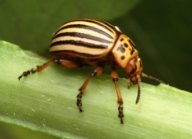
One potato, two potato three potato, four … We’ve been asked to look after our neighbours’ (Carol and Alan) garden for a week and, as they have a Colorado Beetle (CB) infestation on their potatoes, one of the tasks was to pick them off by hand each day. I was shocked to see that every plant had at least one of two fully-grown beetles and there were also plenty of larvae munching away, so I set to armed with gloves and a jar of soapy water (Stuart just squashes them between his fingers … ugh!)
Knowing almost nothing about CB I looked on the web for information and organic controls. I found a great site from America, the National Sustainable Agriculture Information Service, which has some excellent free downloadable resources on many subjects. According to one study, mulching with straw might reduce the beetles’ ability to locate potatoes, and also creates an environment that favours the beetles’ predators. By a happy coincidence, we’ve gone for an experimental ‘no-dig’ straw-mulched bed for our potatoes so I was delighted to learn that this was probably also protecting us from this pest.
It also said that CB has several natural enemies, but they are rarely seen in commercial potato fields because of heavy pesticide use and lack of habitat to support them. Increasing habitat for natural enemies by providing pollen and nectar sources along borders can increase the effectiveness of these biological controls. The generalist predators—ladybird beetles, lacewings, spiders, etc.—provide some control although they will probably not completely control them.
A number of herbs and herbal extracts are also reputed to repel or inhibit the beetles, though it was stated that research has been far from thorough. Among the plants believed to have some effect are: catnip, tansy, sage, hemp, oak extract, wild potato (Solanum chacoense), and citrus oils. This made me think that if sage juice will help deter the Colorado, perhaps it would be a good companion plant for the potato patch. I will definitely be planting more sage around the garden and we’ll see!
